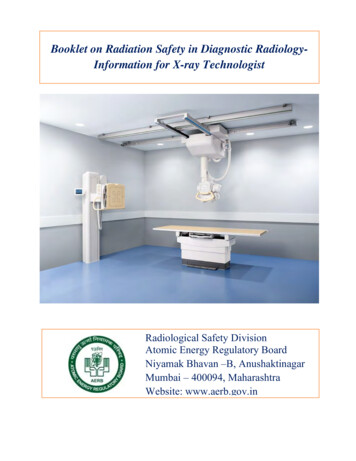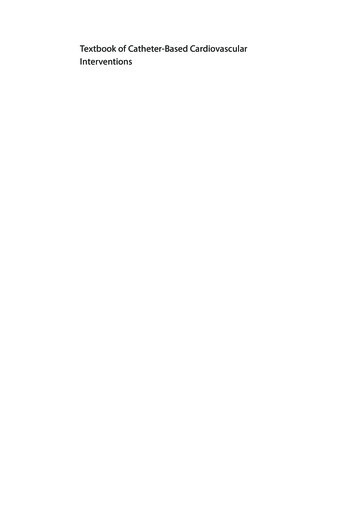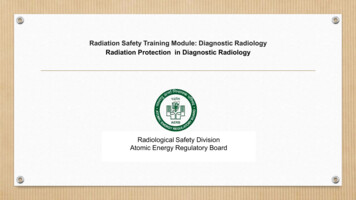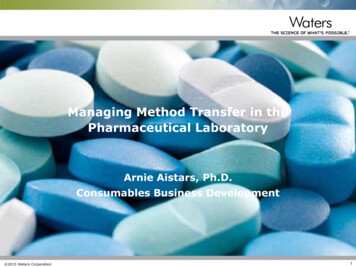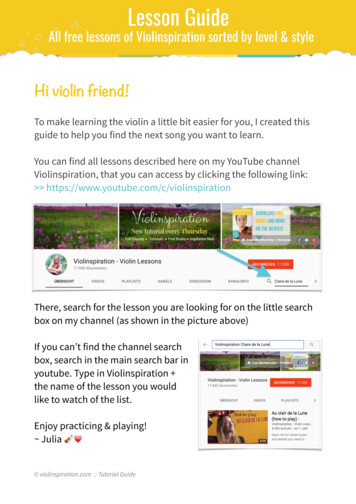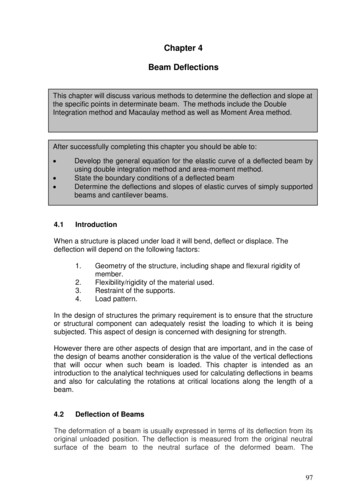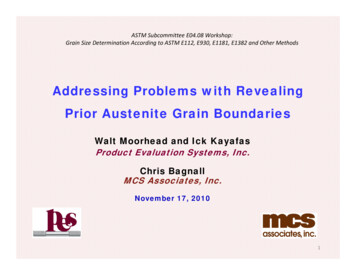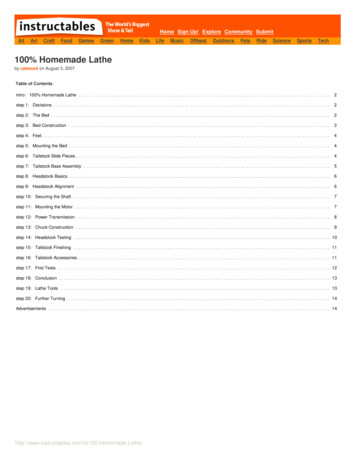
Transcription
EDUCATIONAL RESEARCHAn interventional approach “Jigsaw method” in combination with a lecture toimprove the understanding of Clinical Microbiology for second MBBS studentsA.Swathi ,1 H.R.V.Rajkumar21Assistant professor, 2Professor and Head, Department of Microbiology, Kamineni Academy of MedicalSciences and Research Centre, LB Nagar, Hyderabad, Telangana stateReceived: 25/11/2017 Revised: 27/11/2017 Accepted: 30/11/2017Abstract:Introduction: The Medical Council of India (Vision 2015) as well as The ‘SPICES’ model ofmedical curriculum categorically emphasizes self-directed learning and encourages learner centricapproaches. The Jigsaw method is a form of cooperative learning, in which students are activelyinvolved in the teaching-learning process. Active engagement of learners has shown to improvelong-term retention of acquired knowledge. In Medical Microbiology, students often feel difficultyin understanding, comprehending and interpreting the clinical case scenarios. Therefore the presentstudy was conducted to evaluate the effectiveness of “Jigsaw method” in combination with lectureto improve the understanding of Clinical Microbiology for second MBBS students and to assess thestudents’ knowledge in understanding clinical microbiology case scenario by pre and post testquestionnaire.Methods: The study was conducted with 75 students and 4 faculty members. A topic was selectedand the content was prepared. The topic was initially taught by lecture and after one week thestudents were put for the intervention “Jigsaw”. The pretest and post test was conducted andfeedback was collected from both the students and faculty.Results: There was a significant improvement in the posttest scores of the students after Jigsaw.28% of the students scored 75% in the pretest while 78.6% of the students scored 75% in thepost test .Both the students and the faculty gave a satisfactory feedback based on the Likerts ratingscale.Conclusion: Traditional didactic lecture method needs to be complemented by interactive methodlike Jig Saw to facilitate learning among medical students.Keywords: Jigsaw method, interventional approach, Medical MicrobiologyIntroduction:The ‘SPICES’ model of medical curriculumrecommends a paradigm shift from teachercentered to student-centered learning. 1TheMedical Council of India (Vision 2015) alsoemphasizes self-directed learning and encouragesAddress of Correspondence:Dr.A.SwathiAssistant professor, Department of Microbiology,Kamineni Academy of Medical Sciencesand Research Centre, LB Nagar, Hyderabad- 500068,Telangana stateEmail id: drswathi.gurajala@gmail.comlearner centric approaches.2 Active engagement oflearners has shown to improve long-term retentionof acquired knowledge.Incorporation of active learning strategies like“Jigsaw method “into conventional passivelearning approaches has resulted in improvedstudents’ performance. The Jigsaw method(JT) isa form of cooperative learning, in which studentsare actively involved in the teaching-learningprocess.125
According to Aronson and Patnoe, Jigsaw, is awell-established method for encouraging groupsharing and learning of specific content. Thistechnique is used as an instructional activityacross several days and is best to use when there isa large amount of content to teach. Furthermore,James states that in small group work andcooperative learning, students learn best whenthey are actively involved in the process.3Researchers report that, regardless of the subjectmatter, student working in small groups tend tolearn more of what is taught and retain it longerthan when the same content is presented in otherinstructional formats.4However, a literature search returns limitedevidence of its use in medical education.The present study was taken with an objective tostudy the effectiveness of “Jigsaw method” incombination with lecture in enhancing cognitiveskills in clinical microbiology and to assess thestudent perception towards cooperative groupactivities.The students were divided initially into 5 “homegroups” comprising of 5 students and then subgrouped into “expert groups” as depicted in thefigure 1. Pretest was conducted. The content wasprovided to the expert groups. After discussion,the expert group again joined their home groupsand presented to each other. Post test wasconducted and feedback was taken from thestudents and faculty.Statistical analysis was done by chi square test.MATERIAL & METHODSA quasiexperimental study was conducted afterthe Institutional ethical committee clearance wasobtained. The study was conducted by theDepartment of Microbiology in a tertiary careteaching hospital.The Study population selected was second MBBSstudents comprising of 75 students. Studentconsent was taken for their participation in thestudy.The students strongly agreed that jigsaw washelpful for them in understanding the topic ndetail. The satisfaction level was calculated as 7294% on likerts scale based on questionnaire given.(Figure 3)METHODOLOGY:The primary objective of teaching in medicaleducation is the development of clinicalcompetency and training successful andempoweredgraduateswithprofessionalcompetency so that they can use knowledge forproblem solving in their careers. MCI vision 2015envisages that the Indian Medical Graduates willhave the necessary competencies (Knowledge,Skills and Attitudes) to assume his or her role ashealth care providers. Hence the modificationshave been made in the existing curricula toaccommodate the aspirations of the defined goals,The faculty of the Department was sensitizedabout the Jigsaw methodology. The topic selected“Pyrexia of unknown origin” and the requiredcontent was prepared by the faculty. The topic wasinitially taken as a lecture for all the students. For“Jigsaw”, 3 sessions were conducted comprisingof 25 students each after 1 week. Pretest, posttestquestionnaire in the form of MCQs and feedbackforms were prepared.RESULTS:75 students participated in the study.Pretest, post test results and feedback collectedwere analyzed.The students post test score were significantlyimproved after Jigsaw compared to lecture.(Figure 2). 28% of the students scored 75% inthe pretest while 78.6% of the students scored 75% in the post test. P value was 0.05The faculty also strongly agreed that jigsawmethod can be included in the interactive teachingsessions to complement the lecture. (figure4)Discussion:26
competencies and greater emphasis on cooperative learning. 5The dominant teaching strategy is lecture in mostof the colleges and existing data says that 80% ofeducational content is forgotten within 8 weeksusing this method.6 Teachers like to use lecturebecause it can be applied in large classes. Factorssuch as high volume of educational topics, timelimit, lack of need to particular physical space andimplementation in large classes are among themain reasons why teachers prefer to use lecturemethod. However, it is the one-way training andcan quickly become boring and prevent effectivelearning of students. So interactive teachingsessions can be planned especially for smallgroups to maintain the interest in the ized by Joyce and Weill emphasize on theformation of learning groups, working togetherand collaboration, effective communications,energy generation and that the teacher managesthe class using collaboration.7In our study, we have observed that the post testscores significantly improved after the JT.Srivastava, et al. studied effect of interactive intragroup teaching, where they found significantdifference in the post-test scores by interactivemethod as compared to traditional teachingmethod. 8 Saleh, et al. compared didactic lectureswith interactive sessions in small group teachingand found that students in interactive sessions,performed better. They also found a positiveattitude among students toward interactivesessions. 9Pragnesh parmar etal also observed thatthere was significance increase in mean post testscore for the innovative teachingmethods for all topics.10According to Vinod kumar et al the evaluation ofthe Jigsaw method of teaching by Kirkpatrickevaluation framework suggests that Jigsaw is aneffective teaching-learning tool and has an impacton the learning outcome among the students and isacceptable to them.6In the present study we took the students feedbackby a questionnaire and we found that studentshave taken up this interventional approach with apositive attitude. Many students were of theopinion that this type of sessions should beconducted more often. Lakshmi R also reportedthat Jig saw technique was found to be effective inteaching students. 11 Bassendowski and Petruckaemployed the jigsaw strategy at the University ofSaskatchewan and their study demonstrated thatthis approach was highly effective in generatingand delivering comprehensive information fromand to the students.12Eldin studied the effectiveness of the jigsawstrategy on student participant’s learning atDamanhour University and showed that thestudents gained knowledge from the interactivelearning process.13 The study showed that thestudents enjoyed the method and that the approachwas effective in improving the academic scores ofthe students.Persky and Pollack assessed the use of jigsawapproach in teaching renal clearance conceptsamong a group of medical students and showedthat the jigsaw approach was successful inenabling learning among students.14In general we observed that “When you teach, youlearn twice”. Jigsaw Promotes student’smotivation in learning, Develops positive attitude,Develops interpersonal skills, develops selfconfidence communication among students ,student support , logical thinking, ability inproblem solving, motivation , and criticalthinking. The student’s attention is more focused.Slow learners will be benefitedThe faculty was also of the opinion that Jigsawhas to be incorporated in to the existing teachingBut there were a few limitations like the studycould be conducted only on one topic, only half ofthe batch of 150 students was involved. The otherhalf could not get chance to participate in thissession, time constraint is one of the challenges ofusing the jigsaw technique; as performing jigsawactivities in a class can be time-consuming, proper27
time management is absolutely necessarymethodology which will drive students to learn aparticular topic.In their study, Moskowitz et al showed that theeffect of Jigsaw method was less than that ofother interactive teaching methods used in thechemistry course. 15 It should be noted that theineffectiveness of this method may pertain to theteachers’ unfamiliar with it as well as lack ofcompetency of teachers in the application ofmodern teaching methods (such as Jigsaw).Therefore in-service training programs aresuggested for teachers that they must participateand become familiar with its benefits in learningand its effects on the success of students .16References:1. Haghani F, Rahimi M, Ehsanpour S. Aninvestigation of perceived feedback in clinicaleducation of midwifery students in IsfahanUniversity of medical sciences. IJME.2014;14(7):571-580.2. Naeemi Hoseini F, Zare H, Hormozi M,Shaghagi F, Kaveh MH. A comparison of theeffects of blended learning and lecture-basedinstruction on the students’ academic motivationand satisfaction. Srttu .2012; 7(1):13-23.3. Karimi Monaghi H, Rad M, Bakhshi M. Do theNew Methods of Teaching in Medical Educationhave Adequate Efficacy? A Systematic Review.SDME. 2013; 10(2):153-162.4. Solati SM, Javadi R, Hosseini Teshnizi S,Asghari N. Desirability of two participatorymethods of teaching, based on students’ viewpoint.Bimonthly Journal of HormozganUniversity of Medical Sciences. 2010 Oct;14(3):191-7.5.Vision 2015. Medical council of India.Published in March 20116. Vinod Kumar, C.S., Suneeta Kalasuramath,Satish Patil, K.G. Raghu Kumar, K.R. Shama Taj,V.L. Jayasimha, K.G. Basavarajappa, P.Shashikala, Anand Kukkamalla and ThomasChacko. Effect of Jigsaw Co-Operative LearningCONCLUSIONToday active teaching methods are emphasized innew curriculums in which students play the mainrole in learning. Jigsaw is one of the mostimportant teaching methods. It improvesteamwork and interpersonal communication,thinking, and problem-solving skills. In addition,it can promote learning among postgraduate andundergraduate students.Acknowledgements: Prof and Head, Department of Microbiology, IEC -for giving ethical clearance All the students who gave consent for the study. The faculty of the Department of Microbiologyfor their continuous supportMethod in Improving Cognitive Skills amongMedical Students. Int.J.Curr.Microbiol.App.Sci.2017. 6(3): 164-173.7. Hossein Karimi Moonaghi1, Maryam Bagheri1.Jigsaw: A good student-centered method inmedical education.FMEJ ; 2017(7)8. Srivastava T, Waghmare L. Interactive intragroup tutorials: A modification to suit thechallenges of physiology tutorial in rural medicalschools. Natl J Physiol Pharm Pharmacol., 2014;4(1): 1.9. Saleh AM, Al-tawil NG, Al-hadithi TS.Didactic Lectures and Interactive Sessions inSmall Groups : A Comparative Study amongUndergraduate Students in Hawler College ofMedicine. British Journal of Education, Society &Behavioral Science. 2013; 3(2): 144–5310. Parmar P, Rathod GB. Study of innovativeteaching methods to enhance teaching andlearning in Forensic Medicine. IAIM.2015; 2(8): 7880.11. Lakshmi, R. Visiting cooperative teachinglearning: A study to assess the effectiveness of itsapplication to Arab nursing students, at OmanNursing Institute, Muscat. The Journal of NursingTrendz. 2013; 4(3): 21-25.28
12.Bassendowski, S. L., & Petrucka, P. M. Puzzlepatterns: Research day interactive strategy. Nurseeducation in practice .2006; 6(1): 40-46.13.ElDin, Y. K. Z. Implementing InteractiveNursing Administration lectures and identifyingits influence on students’ learning gains. J NursEduc Pract .2014; 4(5):10714. Persky, A. M., & Pollack, G. M. A hybridjigsaw approach to teaching renal clearanceconcepts. Am J pharm educ . 2009; 73(3):1-6.15.Doymus K, Karacop A, Simsek U. Effects ofjigsaw and animation techniques on studentsunderstanding of concepts and subjects inelectrochemistry. Education tech researchdev.2010.58:671-69116.Bagheri M, azizi SH, Karimi Moonaghi H,mazlom SR, Noruzi HM. The effect of twoteaching methods on nursing and anesthesiologystudent s Learning and satisfaction in basicconcepts of Fundamental Course lessons: jigsawand feedback. A Thesis Presented for the Masterof Sciences Degree in nursing education. 2016.How to Cite this article: Swathi A , Rajkumar H R. An interventional approach “Jigsaw method” in combinationwith a lecture to improve the understanding of Clinical Microbiology for second MBBS students. J EducationalRes & Med Teach 2017;5(2):25-30Funding: Declared noneConflict of interest: Declared noneFigure 1: HOME GROUPS AND EXPERT GROUP FORMATION IN JIGSAW29
Figure 2: PRE AND POST TEST SCORES ANALYSISFigure 3: STUDENTS FEEDBACK ABOUT JTFigure 4: FACULTY FEEDBACK ABOUT JT30
Jun 05, 2018 · An interventional approach “Jigsaw method” in combination with a lecture to improve the understanding of Clinical Microbiology for second MBBS students A.Swathi ,1 H.R.V.Rajkumar2 1Assistant professor, 2Professor and Head, Department of Microbiology, Kamineni Academy of Med
